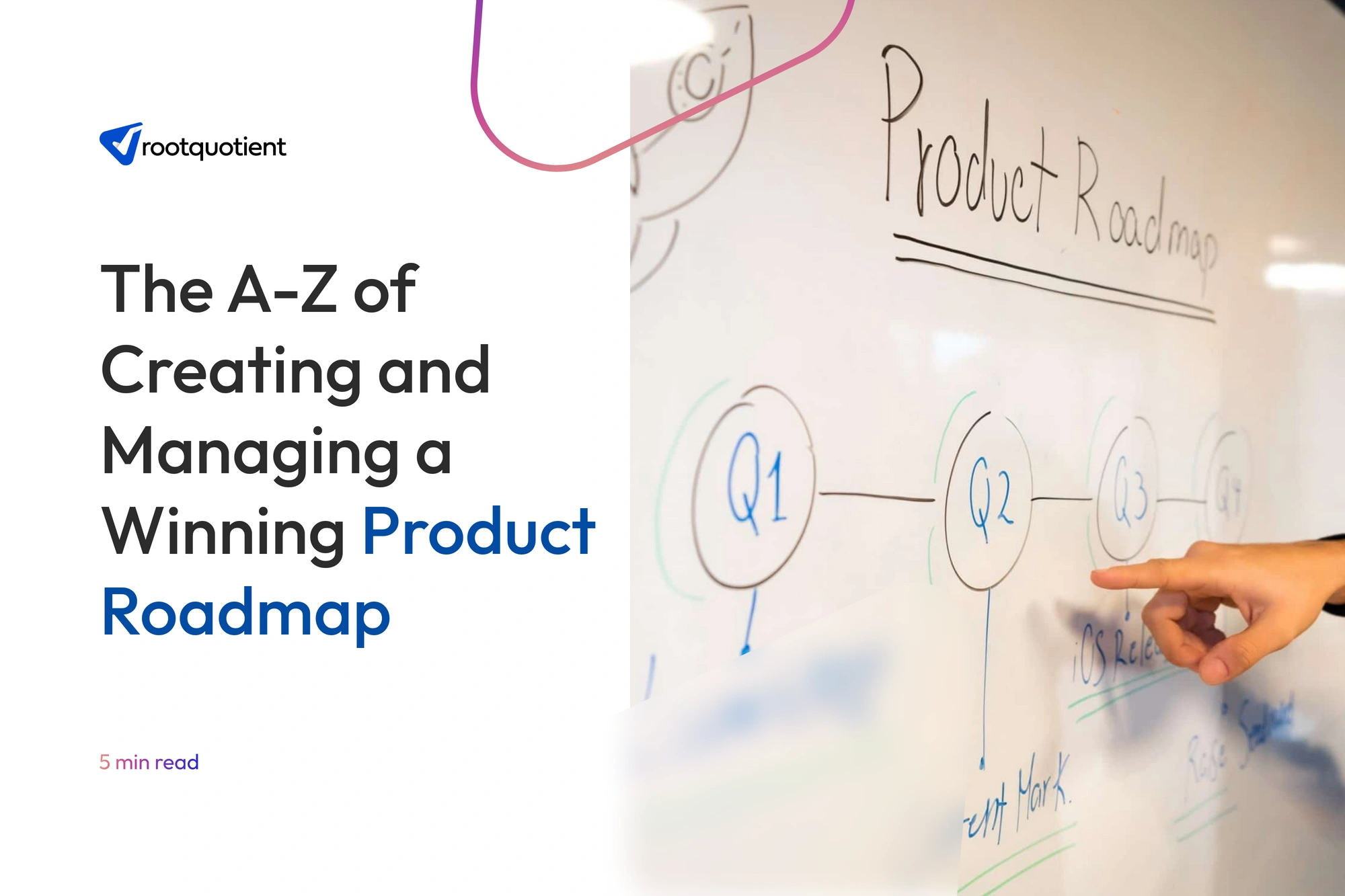Product Roadmapping & Strategy
Most roadmaps fail by chasing features over outcomes. Our strategic product roadmapping service aligns business goals, user needs, and tech feasibility, turning your roadmap into a product development strategy built for clarity, velocity, and long-term value.

How We Build Strategic Product Roadmaps
Product Vision Alignment
We guide teams in defining outcomes that drive the strategic product roadmap, ensuring alignment across stakeholders from day one.
Prioritization With Purpose
Our team applies product roadmapping & strategy frameworks that balance user value, technical feasibility, and business urgency, creating a feature prioritization roadmap that accelerates impact.
MVP & Go-to-Market Planning
We craft MVPs that reduce risk and test assumptions early, combining MVP launch strategy with validated discovery to guide Go-Market Strategy.
Outcome-Led Roadmap Structuring
We structure priorities in stages that reflect product maturity, keeping delivery teams and leadership aligned on measurable value.
Dual-Track Planning & Backlog Hygiene
Our agile product roadmapping approach separates strategy from execution, ensuring your backlog stays clean and your roadmap stays strategic.

Simplifying Personal Finance Management
From Feature Lists to
Business Outcomes
Multi-Dimensional Prioritization
Context-Driven Decisions
Product and Engineering Alignment
Faster Confidence to Ship
Clarity Across Product Horizons
We structure the roadmap to reflect short-term delivery goals, mid-term growth levers, and long-term product bets, ensuring every decision fits within a broader product development strategy.
How Our Approach Delivers Real Product Momentum
No More Endless Backlogs
We bring product roadmap alignment by separating noise from value, ensuring what’s on the roadmap actually moves the needle.

Co-Creation, Not Just Consultation
We work shoulder-to-shoulder with your product and business teams to ensure your roadmap reflects real-world constraints and priorities.

Prioritization Grounded in Context
Instead of rigid formulas, we apply flexible models that weigh user value, effort, and urgency, adapting to product maturity and market needs.

Strategic Readiness, Not Guesswork
We combine insights from product market fit, tech feasibility, and stakeholder feedback to craft roadmaps that are both strategic and executable.

Roadmaps That Adapt and Evolve
We treat the roadmap as a dynamic hypothesis, revised continuously with delivery feedback, adoption metrics, and discovery loops.

Cross-Team
Visibility by Design
We create artifacts that enable shared visibility and alignment across product, design, and engineering, driving execution with clarity.


Conducting in-depth studies to understand user motivations, decision flows, and friction points that shape product engagement.

Analyzing current product experiences against industry best practices and competitor positioning to uncover improvement opportunities.

Structuring navigation, workflows, and interaction patterns that prioritize clarity, usability, and conversion

Creating behavioral personas and mapping end-to-end journeys to ensure every interaction feels intuitive and outcome-driven.
UX Validation

Using qualitative and quantitative feedback to validate design choices, identify early friction points, and optimize for product success.
Strategy That Moves the Product Forward
“We had experienced people on our project. They were notably fast and better than anyone we’d seen before. The team came on board quickly and excelled for their responsiveness, speed of development, and experience.”
“The team pays close attention to our requirements. Spend time discussing the project with Rootquotient; they’ve been helpful in guiding us”
“Rootquotient is reasonably priced, offers very good communication, and delivers solid work… I’m really happy with them; that’s why our relationship is ongoing”

How does product vision alignment influence roadmap success?
Product vision alignment ensures the product roadmap framework is anchored in a shared, well-defined vision that guides every decision. By achieving stakeholder alignment in product planning early, teams avoid fragmented priorities and wasted resources. Rootquotient applies this by linking strategic objectives to every stage of lifecycle-based roadmap structuring, ensuring engineering-aligned product planning and delivery confidence in product launches. This clarity means each roadmap milestone advances measurable business outcomes instead of drifting toward unrelated features.
What is outcome-driven product planning and how is it applied?
Outcome-driven product planning shifts focus from delivering features to achieving measurable results like adoption rate improvement, retention growth, or time-to-market reduction. Rootquotient integrates adoption signal analysis for roadmaps, product market fit readiness, and discovery-led product strategy into roadmap priorities, ensuring initiatives deliver tangible impact. By framing roadmap goals in business and user terms, we enable context-driven prioritization that adjusts as market conditions or user needs evolve.
How do prioritization models balance user value and technical feasibility?
Prioritization models for product development evaluate each initiative’s user value vs. technical feasibility trade-offs to maximize ROI without creating delivery bottlenecks. Rootquotient uses enterprise feature prioritization models and scale-up product maturity frameworks to ensure early wins align with long-term scalability. This approach helps avoid overloading engineering teams and ensures that strategic features for SaaS product roadmap strategy or fintech product roadmap consulting are sequenced logically for impact and feasibility.
What is backlog hygiene and why is it essential in roadmap management?
Backlog hygiene best practices ensure that the product backlog stays relevant, actionable, and aligned with the current roadmap adaptation and iteration process. Without it, delivery teams risk wasting effort on outdated or low-value work. Rootquotient maintains backlog quality by removing redundant items, refining requirements, and aligning backlog contents with dual-track agile planning. This keeps execution tightly linked to outcome-driven product planning, ensuring delivery confidence in product launches.
How do you align product roadmaps with go-to-market strategies?
Go-to-market strategy alignment ensures that roadmap sequencing matches launch readiness, marketing plans, and adoption goals. Rootquotient integrates startup go-to-market roadmaps and SaaS product roadmap strategy into our planning, ensuring that each release aligns with product market fit readiness and adoption rate optimization. This approach enables teams to launch features with the right messaging, timing, and enablement materials for maximum market impact.
How is MVP scoping handled in a lifecycle-based roadmap?
MVP scoping and validation in a lifecycle-based roadmap ensures the initial product validates core assumptions while supporting scale-up product maturity frameworks for future growth. Rootquotient identifies the most critical adoption drivers, ensures technical feasibility, and aligns MVP delivery with both discovery-led product strategy and engineering-aligned product planning. This creates a strong foundation for iterative roadmap adaptation and iteration as user feedback is collected.





